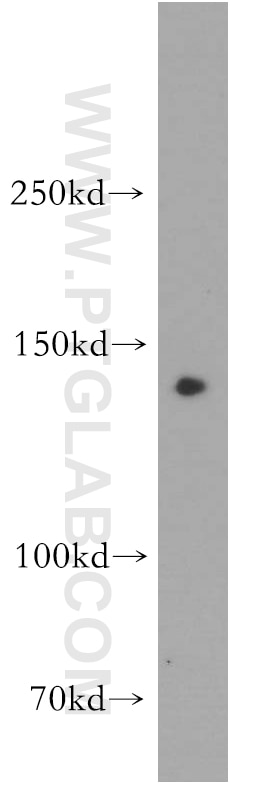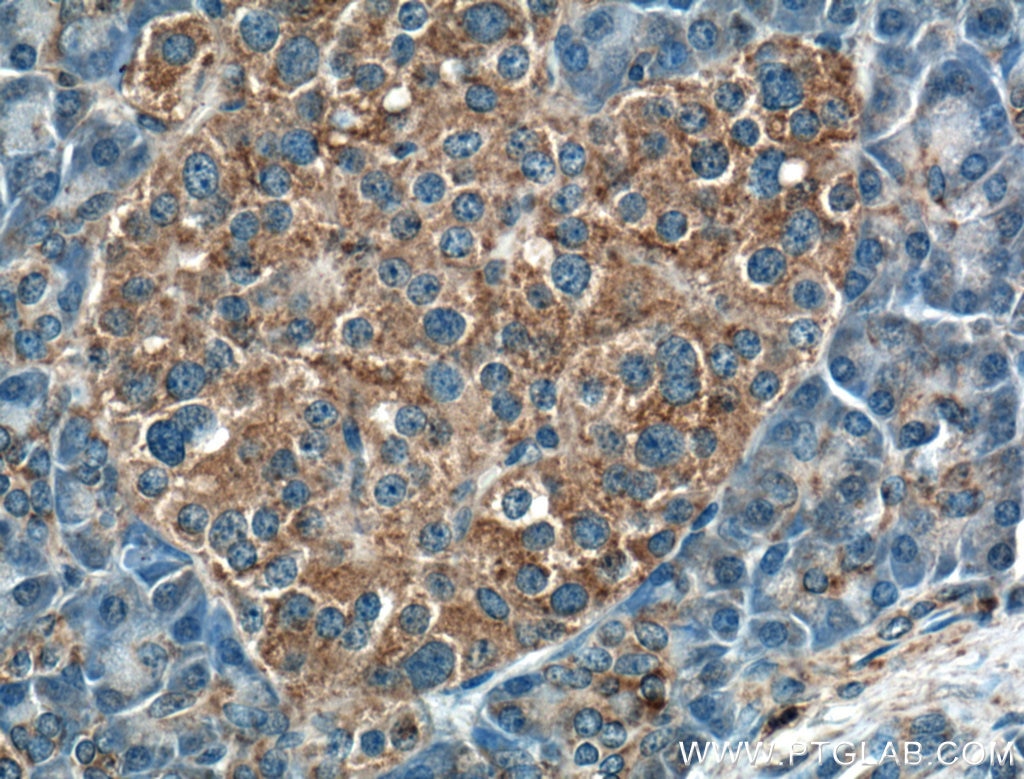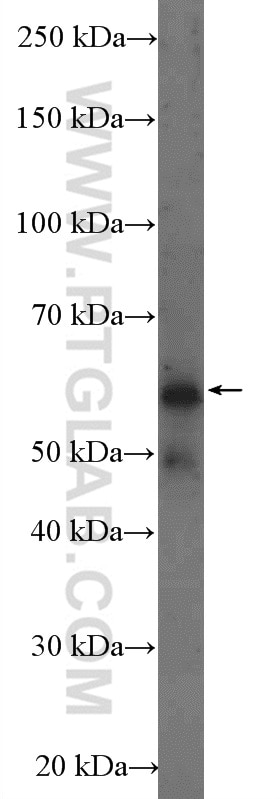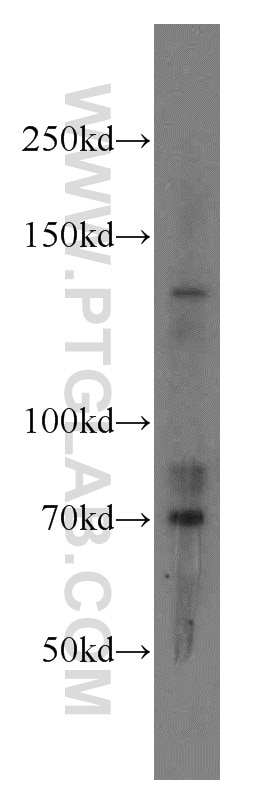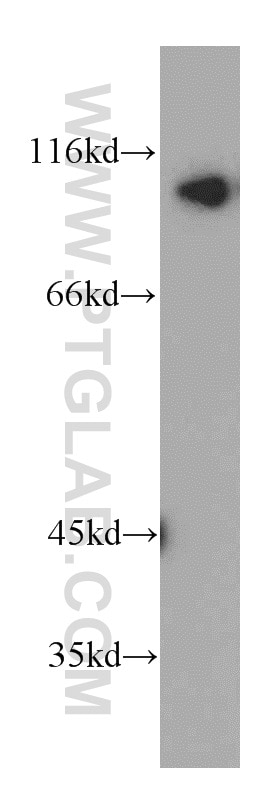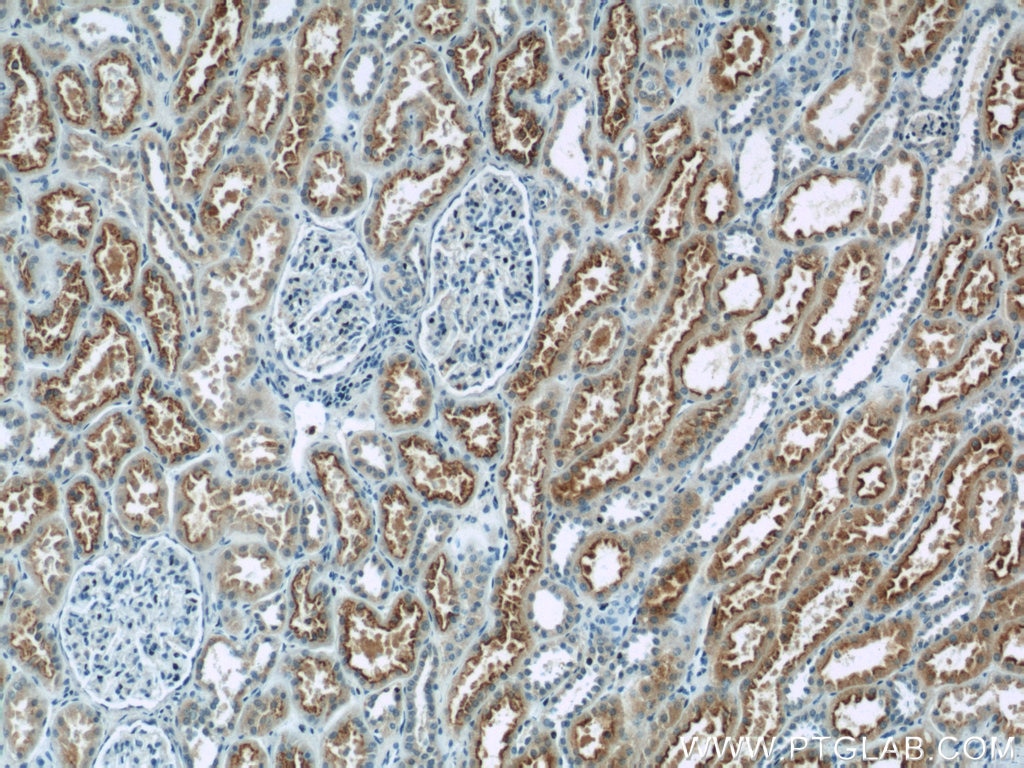- Phare
- Validé par KD/KO
Anticorps Polyclonal de lapin anti-RPGRIP1L
RPGRIP1L Polyclonal Antibody for IHC, IP, WB, ELISA
Hôte / Isotype
Lapin / IgG
Réactivité testée
Humain et plus (3)
Applications
WB, IP, IHC, CoIP, ELISA
Conjugaison
Non conjugué
N° de cat : 55160-1-AP
Synonymes
Galerie de données de validation
Applications testées
| Résultats positifs en WB | cellules HEK-293, tissu rénal humain |
| Résultats positifs en IP | cellules HEK-293 |
| Résultats positifs en IHC | tissu pancréatique humain, tissu cérébral humain il est suggéré de démasquer l'antigène avec un tampon de TE buffer pH 9.0; (*) À défaut, 'le démasquage de l'antigène peut être 'effectué avec un tampon citrate pH 6,0. |
Dilution recommandée
| Application | Dilution |
|---|---|
| Western Blot (WB) | WB : 1:500-1:2000 |
| Immunoprécipitation (IP) | IP : 0.5-4.0 ug for 1.0-3.0 mg of total protein lysate |
| Immunohistochimie (IHC) | IHC : 1:50-1:500 |
| It is recommended that this reagent should be titrated in each testing system to obtain optimal results. | |
| Sample-dependent, check data in validation data gallery | |
Applications publiées
| KD/KO | See 1 publications below |
| WB | See 3 publications below |
| IHC | See 2 publications below |
| CoIP | See 1 publications below |
Informations sur le produit
55160-1-AP cible RPGRIP1L dans les applications de WB, IP, IHC, CoIP, ELISA et montre une réactivité avec des échantillons Humain
| Réactivité | Humain |
| Réactivité citée | canin, Humain, poisson-zèbre, souris |
| Hôte / Isotype | Lapin / IgG |
| Clonalité | Polyclonal |
| Type | Anticorps |
| Immunogène | Peptide |
| Nom complet | RPGRIP1-like |
| Masse moléculaire calculée | 151 kDa |
| Numéro d’acquisition GenBank | NM_015272 |
| Symbole du gène | RPGRIP1L |
| Identification du gène (NCBI) | 23322 |
| Conjugaison | Non conjugué |
| Forme | Liquide |
| Méthode de purification | Purification par affinité contre l'antigène |
| Tampon de stockage | PBS avec azoture de sodium à 0,02 % et glycérol à 50 % pH 7,3 |
| Conditions de stockage | Stocker à -20°C. Stable pendant un an après l'expédition. L'aliquotage n'est pas nécessaire pour le stockage à -20oC Les 20ul contiennent 0,1% de BSA. |
Informations générales
RPGRIP1L, also named as FTM, KIAA1005, belongs to the RPGRIP1 family. It negatively regulates signaling through the G-protein coupled thromboxane A2 receptor. RPGRIP1L may be involved in mechanisms like programmed cell death, craniofacial development, patterning of the limbs, and formation of the left-right axis.(PMID:17558409) Defects in RPGRIP1L are the cause of Joubert syndrome type 7 (JBTS7). Defects in RPGRIP1L are the cause of Meckel syndrome type 5 (MKS5). This antibody is specific to RPGRIP1L.
Protocole
| Product Specific Protocols | |
|---|---|
| WB protocol for RPGRIP1L antibody 55160-1-AP | Download protocol |
| IHC protocol for RPGRIP1L antibody 55160-1-AP | Download protocol |
| IP protocol for RPGRIP1L antibody 55160-1-AP | Download protocol |
| Standard Protocols | |
|---|---|
| Click here to view our Standard Protocols |
Publications
| Species | Application | Title |
|---|---|---|
Nat Cell Biol Early steps in primary cilium assembly require EHD1/EHD3-dependent ciliary vesicle formation. | ||
Nat Cell Biol Early steps in primary cilium assembly require EHD1/EHD3-dependent ciliary vesicle formation. | ||
Sci Adv Ciliopathy protein HYLS1 coordinates the biogenesis and signaling of primary cilia by activating the ciliary lipid kinase PIPKIγ. | ||
Am J Hum Genet Mutations in CSPP1, Encoding a Core Centrosomal Protein, Cause a Range of Ciliopathy Phenotypes in Humans. | ||
J Cell Biol TMEM231, mutated in orofaciodigital and Meckel syndromes, organizes the ciliary transition zone. | ||
Dev Cell Comparative Super-Resolution Mapping of Basal Feet Reveals a Modular but Distinct Architecture in Primary and Motile Cilia. |
Avis
The reviews below have been submitted by verified Proteintech customers who received an incentive forproviding their feedback.
FH Alice (Verified Customer) (01-25-2019) | Cells fixed in MeOH at -20'C for 5mins.Blocked with 1% w/v Milk/PBSRPGRIP1L antibody diluted in block 1:1000 and co-stained with Acetylated alpha-Tubulin and gamma-tubulin.
 |

